Why Is Food Safety Important In Healthcare? Healthcare Leaders Guide
Learn challenges healthcare foodservice teams face today and key food safety practices to protect vulnerable patients. Get a free healthcare leader...
An EHO's main job is to ensure that every food business is up to code and that public health is protected from hazards.
To uphold a high level of food safety, local and federal authorities exercise every effort to ensure that food businesses comply with food safety regulations. Food safety inspections are a common scenario for every food business, and a visit from the environmental health officer (EHO) is something business owners should expect.
Inspections represent the environmental health departments in reducing the causes of foodborne illnesses and protecting consumers from food malpractice.
If you have been in the food industry for long enough, you may have already encountered a visit from an EHO. These visits will give you an overview of the team's food handling practices and address food safety issues.
EHO stands for Environmental Health Officer. An EHO is a government-appointed employee tasked to ensure businesses' compliance with environmental codes to protect public health and the environment.
Environmental Health Officers are also called public health inspectors or environmental health technicians. They are professionals with technical skills and a wide range of knowledge on food hygiene, workplace health, and environmental health matters.
An EHO can be appointed from a federal, state, or local level to examine businesses. The EHO's task includes ensuring that companies manage their waste and that their activities do not negatively affect the environment and the public.
WHAT WE'LL COVER
An Environmental Health Officer's main job is to protect public health from the potential health hazards present in their environment. To do this, they perform on-site inspections of businesses.
The EHO conducts inspections to ensure that your business operates based on the approved Food Law Code of Practice and to prevent environmental health issues.
Under each interpretation of the Food Law Code of Practice in the countries of the UK, EHOs are given powers such as the following:
In addition to performing inspections, environmental health practitioners are responsible for enforcing hygiene protocols in food businesses. They also offer advice on how to improve your hygiene rating. EHOs help prevent the spread of infectious diseases through foods.
Environmental Health Practitioners are responsible for several aspects of safety in a community. In addition to inspections, they perform the following environmental health roles:
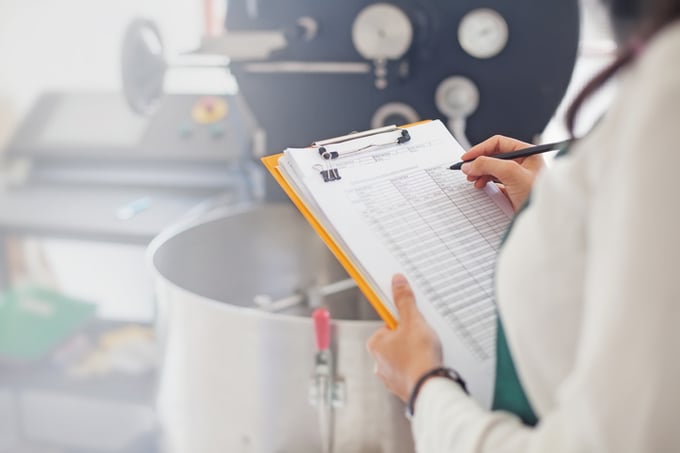
An EHO is tasked to inspect the conditions and operations of your food business. They are responsible for ensuring that the following three areas of your establishment follow the essential food safety regulations:
An EHO is also tasked to write an inspection report about the health risk findings in your food establishment. The report is a summary of your establishment's strengths and weaknesses when it comes to addressing food safety compliance.
Based on the report written by the EHO, you will be given a food hygiene rating scheme score of 1 to 5 that reflects your food safety status. In the United Kingdom, this food safety rating sticker is encouraged or mandated to be posted on visible areas of your store for customers to see. This means that your performance on food safety will significantly affect how the customers will see your food business.
Under the individual interpretations of the Food Law Code of Practice in the countries of the UK, local authorities in public sectors are responsible for appointing Environmental Health Officers.
Individuals appointed to become an EHO are selected based on their relevant food safety qualifications. Such qualifications include expertise and extensiveness on environmental and basic food hygiene issues and relevant legislation.
Most EHOs are health professionals. At a minimum, an EHO must have a relevant degree in environmental health and safety that the Chartered Institute of Environmental Health accredits. This applies to England, Northern Ireland and Wales.
These required relevant skills and degrees ensure the expertise of every environmental health practitioner in making informed decisions about a business's food hygiene status. This also makes environmental enforcement officers qualified to address environmental issues.
An EHO inspection is an on-site assessment of how your food business follows the food safety code of practice. An accredited EHO inspector conducts it. An EHO inspection can be announced in advance or suddenly without any notice. In addition, an inspection may result from a product complaint related to your food business.
In general, the frequency of an inspection is based on the assessed risk level of your operations. High-risk businesses can expect an inspection every six months, whereas a very low-risk food establishment can sometimes be only inspected every three years.
The EHO inspection will become the basis for your food hygiene rating.
The purpose of an EHO inspection is to ensure that your food establishment is working toward maintaining public safety. If anything is not in place, the inspection will reveal your lapses, and the EHO will give you pointers to correct them.
The EHO inspection is not an activity that aims to close down your business but rather one that is made to improve it.
EHO inspections are detailed assessments of your food hygiene status, handling practices, and establishment construction. During the inspection, the EHO will observe how you operate your food business and take notes of the state of your premises.
In general, an EHO inspection aims to evaluate three main areas of your food business operations:
EHOs provide guidance to food businesses through guideline materials and practical training courses as well. In particular, EHOs will:
These checks are grounded in food safety laws and help EHOs determine your compliance with legal hygiene standards.
Under these major areas, more specific practices will be inspected by the EHO. The objective of the inspection is to ensure that your food business follows food safety legislation and standards for food hygiene practices and prevents a food poisoning outbreak.
Ensure that your business has all key inspection areas covered with the help of FoodDocs' intuitive Food Safety Management System. Use our smart tools, such as our real-time dashboard, to manage each key area efficiently. This feature can give you an overview of your food safety status, ensuring that you are compliant with standards of food safety.
Preparing ahead of time can reduce stress and improve your hygiene rating. EHOs expect to see clear documentation and working practices that show you manage food safety daily. Here’s a simple checklist to prepare:
Being able to demonstrate your food safety system in action is one of the best ways to build trust with your EHO.
Environmental Health Officers want to see that food is being handled safely daily, not just on the day of inspection. Here are some key areas they focus on:
Your EHO will provide guidance and feedback during the visit. Use this opportunity to ask questions and show your commitment to food safety.
If an EHO finds anything significantly unsatisfactory that can put consumer health at risk, they are entitled to provide legal notice to your food safety team. Legal notices are a part of food safety laws and health policies that ensure the correction of any potentially hazardous aspect of your food business.
Notices served by an EHO aim to minimize the potential risk of non-compliance on the food you produce. It is also the job of an EHO to ensure that the observed issues are resolved before removing the notice. Disregarding a notice from an EHO may lead to the permanent closure of your business or other legal actions from the EHO.
An EHO visit can occur at any reasonable time during your working week. The EHO is not obligated to give you an advanced notice regarding their visit. The main purpose of an EHO visit is to give you a rating on your food safety performance.
Every food business is legally mandated to escort the EHO and accommodate them to conduct the inspection. It is considered a criminal offence according to environmental legislation to decline an EHO during an inspection.
It is critical to have all monitoring records prepared at any time to ensure that an EHO inspection visit will go smoothly. Common inspections are done to protect the public from disease outbreaks that may come from bad food practices.
In addition to the mentioned reasons for an EHO visit, the frequency of routine checks may vary depending on the risk level of your food business. According to the Food Law Code of Practice, food businesses are categorized and inspected according to the following classifications:
These suggested frequencies of visits may vary in case of emergencies or urgent complaints related to your food business. An EHO will conduct an immediate inspection if you have been recently tagged in a customer complaint or if you are a potential carrier of illegal products.
Frequent visits may be performed if you are operating a high-risk business. In addition, if your business has a bad reputation for having poor compliance with basic cleaning standards, you can expect more frequent visits.
After an inspection, the EHO will provide a comprehensive report on how you handle food and the state of your commercial premises. The report will highlight both the positive and negative areas of your operations.
If you receive an unsatisfactory score or a bad hygiene score, the EHO will provide an explanation of the report and an appropriate solution for your team. Depending on the urgency and the potential severity of the hazard that the non-compliance may cause. The follow-up inspection can be as soon as seven days for urgent concerns and up to 30 days for minor non-compliances.
For more severe shortcomings, an EHO may serve your team with an appropriate notice that may forcibly stop a section of your food business. You must address the concerns and document the actions taken to remove the notice.
Inspections conducted by an EHO may work both ways. If you are unhappy with the result of the inspection or if you do not agree with it, appropriate food laws provide you with the power to file an appeal against the result.
The appeals procedure may be for the FHRS given to your food business or if you disagree with the advice given by the inspector. A part of the appeal includes an in-depth discussion with the inspector. You can formally appeal to your local authority if this does not resolve the case.

The key to getting high marks from an EHO is to be always prepared and ensure that your food safety management system is comprehensive enough to secure compliance. If you have a strong food safety system in place, you won't have to worry about surprise visits as you will always be prepared.
A comprehensive FSMS can help you score great during an EHO inspection. It is one of the critical factors in getting a high score. Food safety management systems make compliance with food laws easier and more efficient.
With our digital solutions at FoodDocs, you can achieve compliance and maintain it effortlessly. With the help of artificial intelligence, our team has developed smart solutions to make compliance with food hygiene laws more efficient and effective.
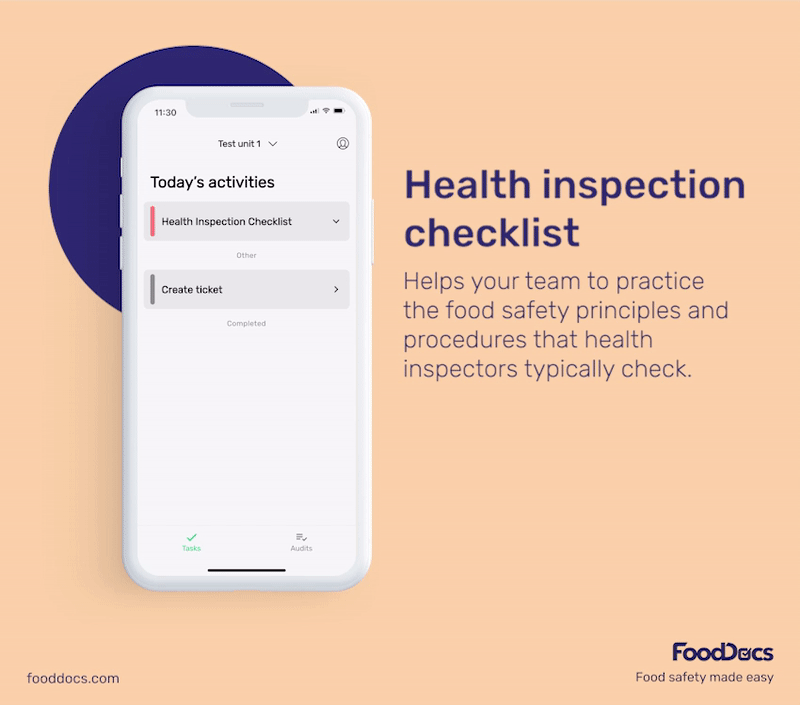
Using our smart software, you can get the following solutions:
To ensure that all food handlers are reminded of critical food safety tasks, use our digital food safety system's smart notification system. This feature was designed to remind food handlers whenever a task is due.
Set up reminders for time-sensitive tasks and allow our system to remind specific employees which task needs to be done. With the help of this smart feature, you can ensure that your business is compliant with critical food safety tasks all the time.
You can also use this notification system to alert you whenever critical documents, like certificates, staff training records, and EHO ratings, are due. When the document's validity is near its end, our system automatically sends alerts, reminding you for renewal.
Ensure that all monitoring tasks and documents stay current with our smart notification system.
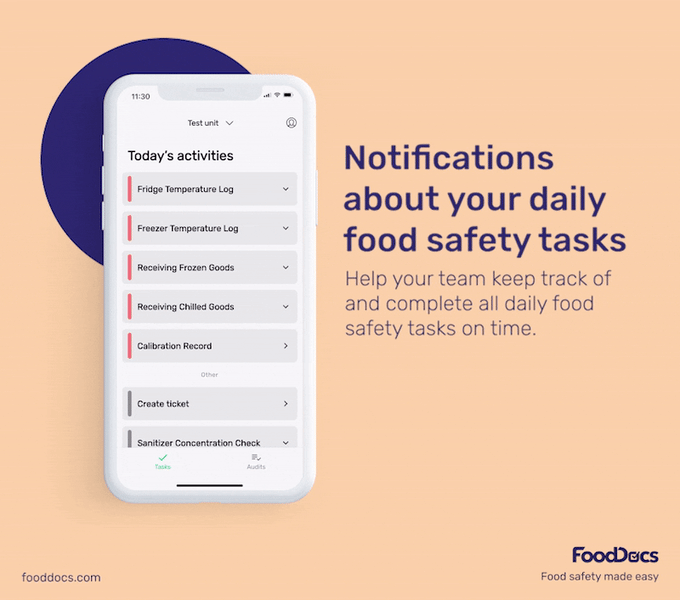
All monitoring tasks automatically generated by our software come with detailed step-by-step instructions on how to perform and monitor tasks. These smart tools were added to ensure that every food safety team knows how to execute food safety tasks, such as personal hygiene practices, correctly.
You can use this feature to provide adequate food hygiene training about the key areas of an EHO inspection and prepare them for a visit. These instructions can also be used for onboarding new food employees and ensuring that they are well-trained for any EHO inspection visit.
Our system also allows you to upload your version of task instructions. Upload personalized instructions as images or videos according to the needs of your business premises whenever you like.
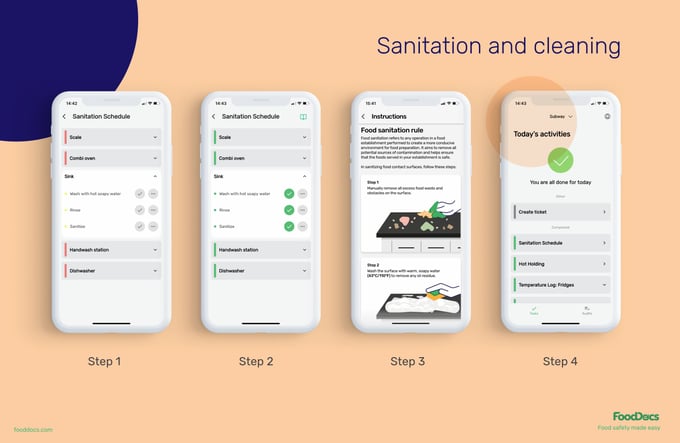
Incorporate your in-house inspection checklists into our food safety audit tools. Our smart software features an auditing system that allows you to perform critical inspections anytime.
Upload pre-existing audit checklists or create new audit lists using our food safety audit feature and conduct inspections using our food safety app.
You can use this feature to identify areas in your food premises that require major improvements and address them with enforcement actions before an actual EHO visit. Use the evaluation reports to improve your operations.
Schedule quarterly or yearly audits easily using our food safety software.
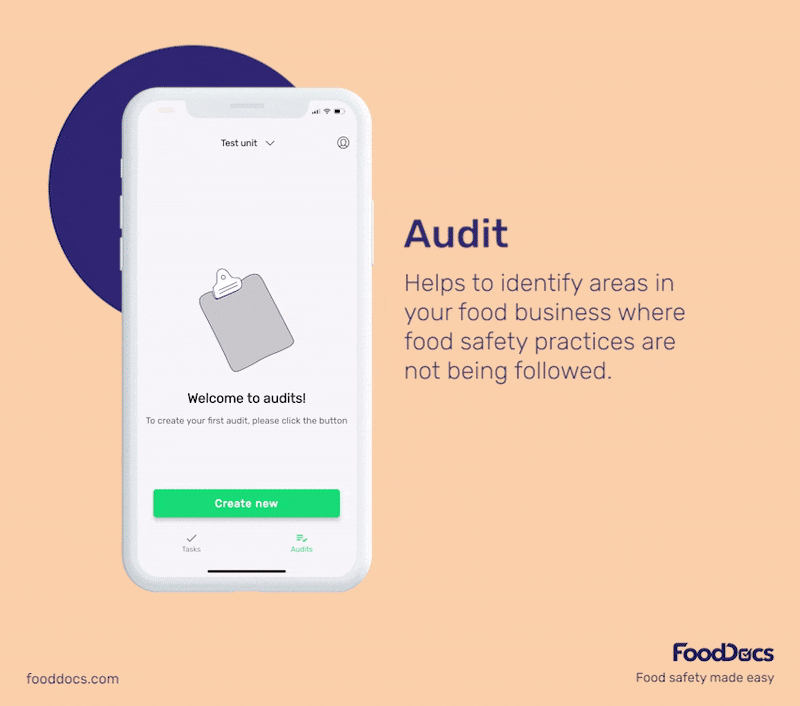
To help you manage your everyday operations, our system also offers a real-time food safety dashboard. You can get an overview of your daily operations and easily identify areas that need more attention.
This food safety software feature was designed to help food safety managers improve management efficiency. The dashboard shows the status of each monitoring log and allows you to ensure that tasks are done according to your requirements.
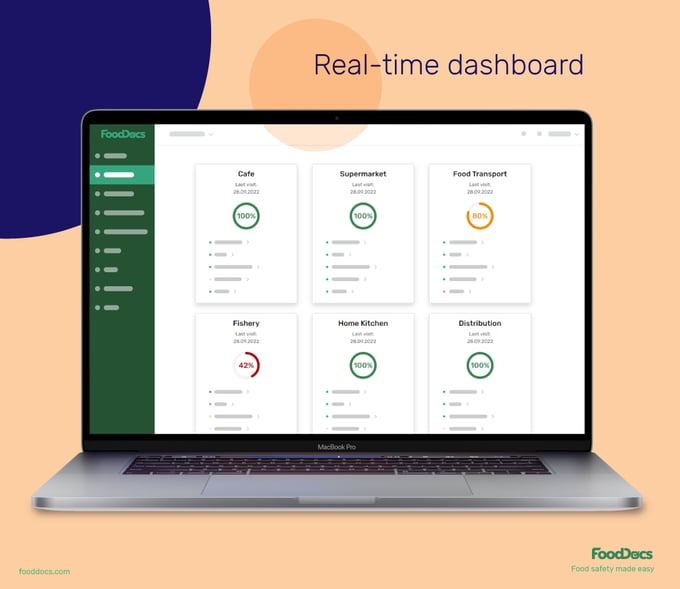
With our digital solutions, scoring a 5-star food hygiene rating will always be easy. It does not matter if you do not have prior knowledge of food safety and hygiene laws, as our system can help you comply with critical environmental health standards.
Use our wide range of smart tools and features to ensure that basic safe food practices and requirements are always done on time and correctly. With FoodDocs' smart system, managing food safety compliance can be more efficient and comprehensive enough to impress an EHO.
Control food hygiene concerns before even causing any problems and create a thorough food safety documentation of your compliance records to make EHO inspection visits faster.
Book a free demo with our specialists to learn more about how our system can help you prepare for an EHO inspection.
To help you understand more about EHO inspection, here are a few of the most common questions asked regarding this topic:
EHO stands for "Environmental Health Officer" in food safety.
An Environmental Health Officer (EHO) inspects and monitors food establishments to ensure compliance with health and hygiene regulations.
An EHO is responsible for enforcing food hygiene laws and regulations, investigating formal complaints about food safety, conducting routine inspections, and providing guidance and advice to food businesses.
Environmental Health Officers have the authority to enforce various notices, including improvement notices, prohibition orders, and emergency prohibition orders, to address and rectify non-compliance with food safety regulations.
The best way to prepare for an EHO inspection is to establish a comprehensive food safety management system. This system can help you ensure that your business is compliant with food hygiene laws.
An Environmental Health Officer can enforce compliance with food safety regulations and standards by issuing improvement notices, prohibition orders, and emergency prohibition orders, requiring corrective actions to be taken to address violations and ensure public safety. These enforcement actions aim to achieve health promotion and protect consumers from food safety hazards.
Yes, an Environmental Health Officer can issue on-the-spot fines or penalties for critical violations of mandatory requirements and dangerous food practices, affecting your overall food hygiene rating. Such fines require immediate compliance and urgent improvement of operations.
If an EHO comes to your food establishment, cooperate with them during the inspection. Answer their questions truthfully, provide access to monitoring records, provide samples of food per request, and be ready to address any violations or areas of concern they identify.
You should have cleaning records, temperature logs, staff training certificates, pest control reports, and your food safety management system available for review.
Yes, if there’s an immediate risk to public health, an EHO can issue a Hygiene Emergency Prohibition Notice and seek a court order to close the business.
A critical control point (CCP) is a step in your food process where controls are essential to prevent or eliminate food safety hazards—such as cooking food to the right temperature.
No, EHOs do not have to give noticed before visiting. Environmental Health Officers usually inspect without notice to see how a food business operates under normal conditions.
Learn challenges healthcare foodservice teams face today and key food safety practices to protect vulnerable patients. Get a free healthcare leader...
Learn what Standard Operating Procedures (SOPs) are and how to write effective SOPs that ensure consistency, efficiency, and safety in your...
Boost your retail food safety with essential practices and digital tools to protect customers and your brand. Plus a free Retail Food Safety Leader...